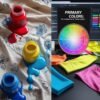
“Eco-Friendly Textiles: How to Choose Sustainable Fabrics for Your Next Project”
Eco-Friendly Textiles
Choosing Sustainable Fabrics for Your Next Project
In a world increasingly aware of climate change and fast fashion’s toll, eco-friendly textiles are a necessity. This guide helps you pick the perfect planet-friendly fabric, combining sustainability with style and creativity.
What Makes a Textile Sustainable?
Sustainable fabrics minimize environmental harm at every stage of their lifecycle: from farming and production to dyeing and eventual disposal. The goal is to reduce resource consumption, pollution, and waste, while often promoting ethical labor practices.
Each step offers opportunities for eco-friendly choices, contributing to a healthier planet.
Top Eco-Friendly Fabric Options
1. Organic Cotton
Grown without synthetic pesticides or GMOs.
Uses 91% Less Water
(Compared to conventional cotton)
Best for: Soft apparel, home textiles.
Pro Tip: Look for GOTS certification.
2. Recycled Polyester
Made from recycled plastics (e.g., bottles).
Uses 59% Less Energy
(Compared to virgin polyester)
Best for: Activewear, bags, upholstery.
Pro Tip: Holds vibrant digital prints well.
3. Hemp
Fast-growing, needs minimal water & no pesticides.
Absorbs More CO₂
(Than trees, and improves soil health)
Best for: Canvas, towels, eco-denim.
4. Linen
Made from flax; biodegradable & moth-resistant.
Zero Waste Material
(Entire flax plant is utilized)
Best for: Summer clothes, tablecloths.
5. Tencel (Lyocell)
Silky fabric from sustainably harvested wood pulp.
99% Solvents Recycled
(In a closed-loop production system)
Best for: Luxe loungewear, bedsheets.
6. Bamboo
Fibers spun into soft, antibacterial fabric.
Grows Rapidly
(Without fertilizers, but ensure mechanical processing)
Best for: Socks, underwear, baby clothes.
Fabric Comparison Snapshot
A quick look at key sustainability aspects of common eco-friendly fabrics. Ratings are relative (Low, Med, High) based on general knowledge from the source text.
| Fabric | Water Usage | Carbon Footprint (Est.) | Key Certifications | Primary Benefit |
|---|---|---|---|---|
| Organic Cotton | Low | Med-Low | GOTS | Reduced water, no pesticides |
| Recycled Polyester | Med (vs virgin) | Low (vs virgin) | GRS | Reduces plastic waste, less energy |
| Hemp | Very Low | Negative (CO2 sink) | Often Organic Certs | Durable, soil health |
| Linen | Low | Med-Low | European Flax | Biodegradable, zero waste plant |
| Tencel (Lyocell) | Med (process focus) | Med-Low | FSC Wood, OEKO-TEX | Closed-loop, soft |
| Bamboo (Mechanical) | Low (growth) | Med | FSC Bamboo, OEKO-TEX | Fast growing, soft |
Note: "Carbon Footprint (Est.)" refers to estimated impact during production relative to conventional alternatives or overall lifecycle. Actual figures vary widely.
Why Sustainable Textiles Matter
The fashion and textile industry has a significant global footprint. Choosing sustainable options is crucial for mitigating these impacts.
- ✔ Environmental Impact: Reduces water waste, chemical runoff, and landfill overflow.
- ✔ Ethical Production: Often supports fair wages and safer working conditions.
- ✔ Health Benefits: Organic fabrics are gentler on skin, reducing allergen exposure.
Fashion Industry's Carbon Emissions
Contributes ~10% of Global Carbon Emissions
How Digital Printing Supports Sustainability (with TPDS.in)
Digital Printing Water Savings
Up to 95% Less Water Than Traditional Dyeing
At TPDS.in, we pair eco-fabrics with eco-friendly printing technology to maximize sustainability:
- 💧Less Water Waste: As shown, significantly cutting down on a precious resource.
- 🌿Non-Toxic Inks: Our water-based inks are free from harmful PVC and phthalates.
- 🎯On-Demand Production: Print only what you need, drastically reducing overstock and waste.
Did You Know?
500+ L
A single digital-printed textile order can save over 500 liters of water compared to conventional methods!
How to Choose the Right Fabric for Your Project
Selecting the ideal sustainable fabric involves considering your project's specific requirements and values.
1. Define Your Needs:
- Apparel: Prioritize breathability & comfort (e.g., organic cotton, linen, Tencel).
- Home Decor: Opt for durability & specific aesthetics (e.g., recycled polyester, hemp).
- Luxury Items: Choose Tencel or high-quality bamboo for a premium feel.
2. Check Certifications:
Labels like GOTS (Global Organic Textile Standard), OEKO-TEX (tested for harmful substances), and GRS (Global Recycled Standard) guarantee eco-friendly and ethical practices.
3. Support Ethical Brands & Ask Questions:
- Partner with suppliers transparent about their supply chain.
- Ask: "Is this fabric biodegradable or recyclable?"
- Ask: "What’s the carbon footprint of production?"
Case Study: A Sustainable Success Story
A Mumbai-based fashion startup aimed for a zero-waste clothing line, choosing recycled polyester for jackets and organic cotton for basics, printed with TPDS.in’s digital technology. The results were remarkable:
40%
Less Water Used in Production
100%
Customer Satisfaction (Bold, Long-Lasting Prints)
They were even featured in Vogue India’s “Green Innovators” list!
How TPDS.in Helps You Go Green
We are committed to making your sustainable vision a reality with our specialized services:
Eco-Inks
Vibrant, durable prints using water-based, non-toxic inks.
Fast Sampling
Test designs on small fabric batches before committing to bulk orders.
Expert Advice
Our team guides you in selecting the perfect sustainable fabric for your project.



